Nepal Tourism Places To Visit offer a diverse range of experiences, from breathtaking Himalayan treks to vibrant cultural sites, and SIXT.VN is here to help you explore them all. Planning a trip to Nepal can be overwhelming, but with our services, you can easily arrange airport transfers, book comfortable accommodations, and discover the best tours. Let’s dive into the must-see attractions and hidden gems that make Nepal a top travel destination, ensuring your journey is smooth and unforgettable with our Nepal travel guide and Nepal vacation spots.
1. Discover Kathmandu: The Cultural Heart of Nepal
Kathmandu, the capital city, is a vibrant hub of culture and history. The city’s blend of ancient temples, bustling markets, and lively streets offers a sensory overload that is both captivating and overwhelming. This is a must-visit destination and a key highlight in any Nepal travel itinerary.
1.1. Explore Durbar Square
Durbar Square, a UNESCO World Heritage Site, is a complex of palaces, temples, and courtyards that showcases Nepal’s rich architectural heritage. Despite the damage from the 2015 earthquake, the square remains a significant cultural and historical site.
- Historical Significance: Durbar Square was the royal palace of the Malla and Shah dynasties.
- Key Attractions:
- Kumari Ghar: The residence of the living goddess, Kumari.
- Hanuman Dhoka: The historic royal palace.
- Various Temples: Including Taleju Temple and Jagannath Temple.
- Restoration Efforts: Ongoing efforts to restore the damaged structures, with some areas already fully repaired.
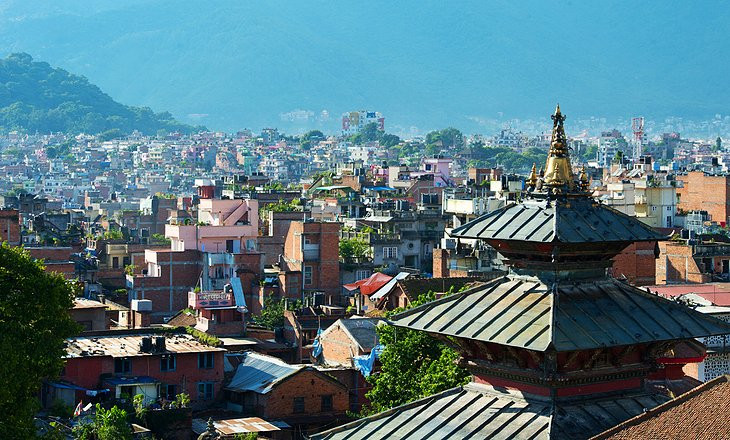 Kathmandu Durbar Square: Ancient temples and monuments showcase Nepal's rich architectural heritage in the heart of the capital
Kathmandu Durbar Square: Ancient temples and monuments showcase Nepal's rich architectural heritage in the heart of the capital
1.2. Visit Swayambhunath (Monkey Temple)
Swayambhunath, also known as the Monkey Temple, is an ancient religious complex atop a hill in the Kathmandu Valley. It offers panoramic views of the city and is adorned with Buddhist and Hindu symbols.
- Religious Significance: One of the oldest religious sites in Nepal.
- Key Features:
- Swayambhu Stupa: The iconic stupa with the eyes of Buddha.
- Monkeys: The temple’s famous inhabitants.
- Panoramic Views: Stunning views of Kathmandu Valley.
- Accessibility: Easily accessible by taxi or local bus.
1.3. Experience Boudhanath Stupa
Boudhanath Stupa is one of the largest spherical stupas in Nepal and a UNESCO World Heritage Site. It is a major center for Tibetan Buddhism and a place of peace and spiritual energy.
- Cultural Importance: A significant pilgrimage site for Buddhists.
- Key Aspects:
- Giant Mandala: The stupa’s design represents the Buddhist cosmos.
- Prayer Wheels: Numerous prayer wheels around the stupa.
- Monasteries: Surrounding monasteries reflecting Tibetan culture.
- Spiritual Atmosphere: A serene environment for meditation and reflection.
2. Explore Pokhara: The Adventure Hub
Pokhara, located in central Nepal, is renowned for its stunning natural beauty and as a gateway to the Annapurna region. The city offers a tranquil escape with its serene lakes, breathtaking mountain views, and numerous adventure activities.
2.1. Relax by Phewa Lake
Phewa Lake is the second largest lake in Nepal and a central attraction in Pokhara. Visitors can enjoy boating, kayaking, and relaxing by the lakeside, with stunning views of the Annapurna range.
- Scenic Beauty: Clear waters reflecting the Annapurna and Dhaulagiri ranges.
- Activities:
- Boating: Rent a boat to explore the lake.
- Kayaking: A peaceful way to enjoy the scenery.
- Lakeside Relaxation: Numerous cafes and restaurants along the shore.
- Tal Barahi Temple: A temple located on an island in the lake.
2.2. Hike to Poon Hill
Poon Hill is a popular hiking destination near Pokhara, known for its panoramic views of the Annapurna and Dhaulagiri mountain ranges. The trek is relatively easy and suitable for all fitness levels.
- Spectacular Views: Unobstructed views of the Himalayas.
- Trekking Details:
- Difficulty: Easy to moderate.
- Duration: Typically a 2-3 day trek.
- Best Time: Early morning for sunrise views.
- Accessibility: Accessible from Pokhara with various tour packages available.
2.3. Visit the International Mountain Museum
The International Mountain Museum in Pokhara showcases the history, culture, and geology of the Himalayan mountains. It offers informative exhibits and displays about mountaineering and the people of the mountains.
- Educational Experience: Learn about the Himalayas and mountaineering.
- Key Exhibits:
- Mountain People Gallery: Showcasing the culture and lifestyle of mountain communities.
- Mountain Gallery: Detailing the geology and formation of the Himalayas.
- Mountaineering Gallery: Displaying equipment and stories of famous climbers.
- Interactive Displays: Engaging exhibits for all ages.
3. Trekking Adventures in Nepal: A Hiker’s Paradise
Nepal is renowned as a world-class trekking destination, offering a wide range of trails for all levels of experience. From the iconic Everest Base Camp to the stunning Annapurna Circuit, Nepal’s trekking routes provide unparalleled views and cultural experiences.
3.1. Everest Base Camp Trek
The Everest Base Camp Trek is one of the most famous treks in the world, offering a challenging but rewarding journey to the foot of the world’s highest mountain.
- Iconic Destination: Trek to the base of Mount Everest.
- Trekking Highlights:
- Lukla: The starting point of the trek, accessible by flight from Kathmandu.
- Namche Bazaar: The main trading center in the Khumbu region.
- Tengboche Monastery: A significant Buddhist monastery with stunning views.
- Everest Base Camp: The ultimate destination, offering breathtaking views of Everest.
- Best Time to Trek: Spring (March-May) and Autumn (September-November).
3.2. Annapurna Circuit Trek
The Annapurna Circuit Trek is a classic Himalayan trek that encircles the Annapurna massif, offering diverse landscapes and cultural experiences.
- Diverse Scenery: From lush green valleys to high mountain passes.
- Trekking Route:
- Besishahar: The starting point of the trek.
- Thorong La Pass: The highest point of the trek at 5,416 meters.
- Muktinath: A sacred pilgrimage site for Hindus and Buddhists.
- Tatopani: Known for its natural hot springs.
- Cultural Encounters: Opportunity to interact with local communities and experience their way of life.
3.3. Langtang Valley Trek
The Langtang Valley Trek is a less crowded but equally stunning trek that offers a close-up view of the Himalayas and a chance to experience the local Tamang culture.
- Serene Environment: Peaceful trails with fewer tourists.
- Trekking Experience:
- Syabrubesi: The starting point of the trek.
- Langtang National Park: Home to diverse flora and fauna.
- Kyanjin Gompa: A Buddhist monastery with panoramic views.
- Langtang Lirung Glacier: Spectacular glacier views.
- Accessibility: Easily accessible from Kathmandu by jeep.
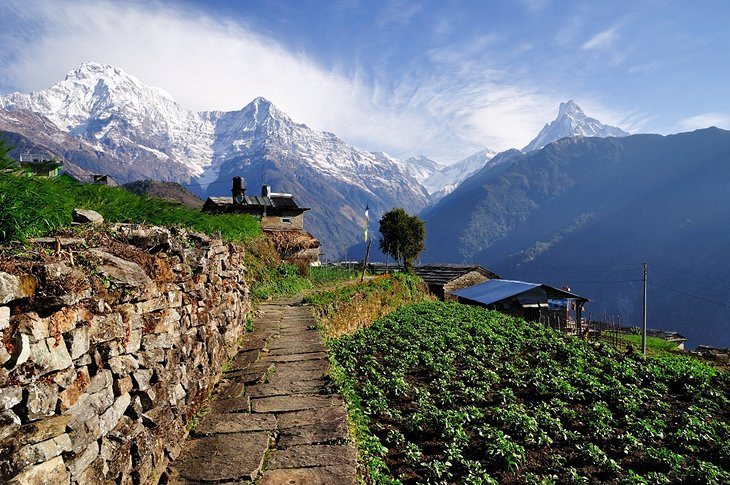 Trekking in the Annapurna Region: Experience the diverse landscapes and cultures of the Himalayas on this classic trek
Trekking in the Annapurna Region: Experience the diverse landscapes and cultures of the Himalayas on this classic trek
4. Wildlife Adventures: Exploring Nepal’s National Parks
Nepal is not just about mountains; it also boasts rich biodiversity and several national parks that offer unique wildlife viewing opportunities. Chitwan National Park and Bardiya National Park are two of the best places to experience Nepal’s wild side.
4.1. Chitwan National Park
Chitwan National Park is a UNESCO World Heritage Site and one of the best places in Nepal to see wildlife, including rhinos, tigers, and elephants.
- Diverse Ecosystem: Subtropical forests, grasslands, and riverine habitats.
- Wildlife Highlights:
- One-Horned Rhinoceros: A major attraction of the park.
- Bengal Tiger: Elusive but present in the park.
- Elephants: Used for safaris and conservation efforts.
- Gharial and Mugger Crocodiles: Found in the rivers.
- Activities:
- Jeep Safaris: Explore the park in a four-wheel-drive vehicle.
- Elephant Safaris: Get close to the wildlife on an elephant’s back.
- Canoe Rides: Enjoy the riverine environment.
- Bird Watching: Over 500 species of birds in the park.
4.2. Bardiya National Park
Bardiya National Park is a less crowded alternative to Chitwan, offering a more remote and pristine wildlife experience.
- Remote Wilderness: Untouched natural beauty.
- Wildlife Encounters:
- Bengal Tigers: A significant population in the park.
- One-Horned Rhinoceros: Thriving population due to conservation efforts.
- Wild Elephants: Roaming freely in the park.
- Gangetic Dolphins: Found in the Karnali River.
- Activities:
- Jeep Safaris: Explore the park’s diverse habitats.
- Walking Safaris: Experience the jungle on foot with a guide.
- Bird Watching: A paradise for bird enthusiasts.
- Community Involvement: Opportunities to support local communities and conservation efforts.
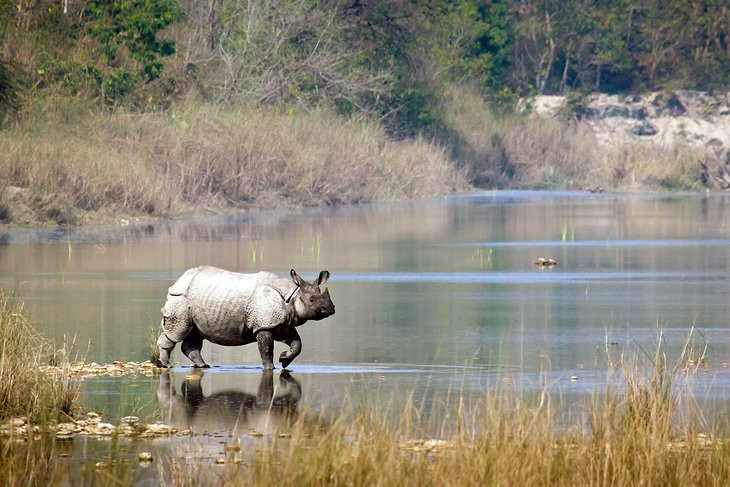 Rhino in Chitwan National Park: Experience Nepal's wild side with diverse wildlife and lush landscapes
Rhino in Chitwan National Park: Experience Nepal's wild side with diverse wildlife and lush landscapes
5. Lumbini: The Birthplace of Buddha
Lumbini, a UNESCO World Heritage Site, is the birthplace of Siddhartha Gautama, the historic Buddha. It is a major pilgrimage site for Buddhists from around the world and a place of peace and spiritual significance.
5.1. Maya Devi Temple
The Maya Devi Temple is the main attraction in Lumbini, marking the spot where Queen Maya Devi gave birth to Buddha.
- Historical Importance: The most sacred site in Lumbini.
- Key Features:
- Birth Marker Stone: Indicating the exact birthplace of Buddha.
- Sacred Garden: Surrounding the temple with ancient ruins and monuments.
- Puskarini Pond: The pond where Queen Maya Devi bathed before giving birth.
- Tranquil Atmosphere: A serene environment for reflection and meditation.
5.2. Ashoka Pillar
The Ashoka Pillar, erected by Emperor Ashoka in 249 BC, is one of the oldest monuments in Lumbini and bears an inscription about Buddha’s birthplace.
- Historical Significance: A testament to the early history of Buddhism.
- Inscription: Provides evidence of Buddha’s birthplace.
- Location: Situated near the Maya Devi Temple.
5.3. Monasteries Zone
The Monasteries Zone in Lumbini features monasteries built by various Buddhist countries, showcasing diverse architectural styles and traditions.
- Cultural Diversity: Monasteries representing different Buddhist traditions.
- Key Monasteries:
- Royal Thai Monastery: Known for its beautiful architecture.
- Chinese Monastery: Featuring traditional Chinese design.
- Korean Monastery: Offering meditation retreats.
- Vietnamese Temple: Reflecting Vietnamese Buddhist art.
- Spiritual Exploration: Opportunity to learn about different Buddhist practices.
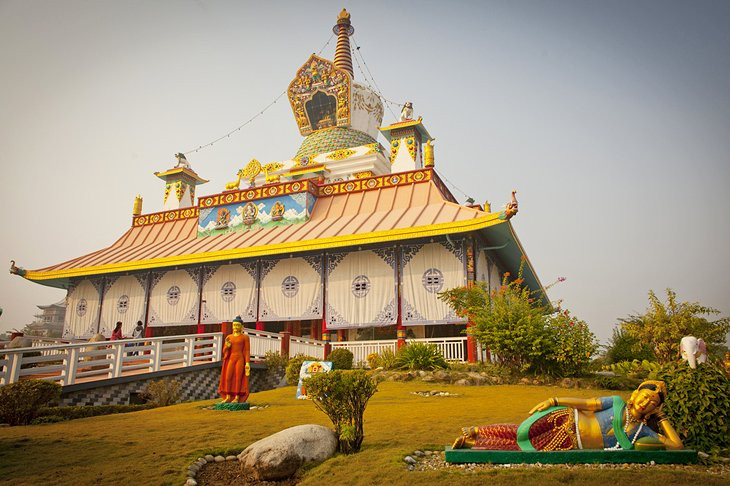 Temples in Lumbini: Visit the birthplace of Buddha and experience tranquility in this sacred pilgrimage town
Temples in Lumbini: Visit the birthplace of Buddha and experience tranquility in this sacred pilgrimage town
6. Beyond the Highlights: Other Must-Visit Places in Nepal
While Kathmandu, Pokhara, and the trekking regions are popular, Nepal offers many other hidden gems worth exploring. These destinations provide unique cultural and natural experiences that are off the beaten path.
6.1. Bhaktapur: The City of Devotees
Bhaktapur, another of the ancient royal cities in the Kathmandu Valley, is known for its well-preserved medieval architecture, pottery, and rich cultural heritage.
- Cultural Preservation: A living museum of traditional Newari culture.
- Key Attractions:
- Durbar Square: Featuring ancient palaces and temples.
- Nyatapola Temple: The tallest temple in Nepal.
- Pottery Square: Witness traditional pottery making.
- Dattatreya Square: Home to ancient temples and monasteries.
- Local Crafts: Opportunities to purchase traditional pottery and handicrafts.
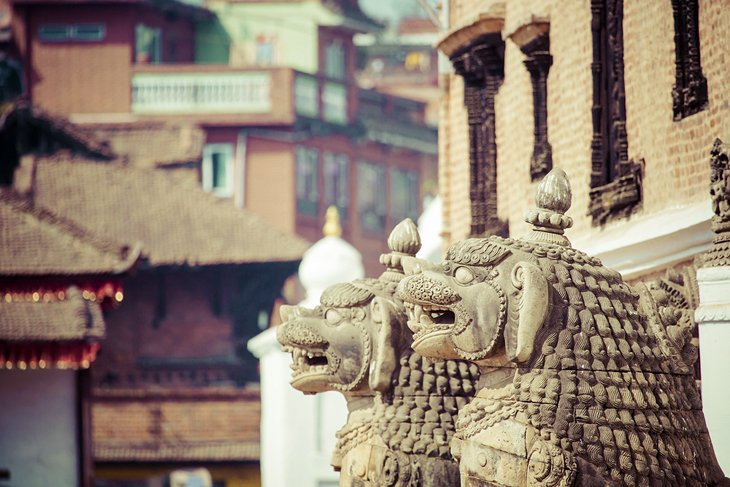 Bhaktapur Durbar Square: Explore the well-preserved medieval architecture and rich cultural heritage of this ancient city
Bhaktapur Durbar Square: Explore the well-preserved medieval architecture and rich cultural heritage of this ancient city
6.2. Nagarkot: Sunrise Views of the Himalayas
Nagarkot is a hill station near Kathmandu, famous for its panoramic views of the Himalayas, especially at sunrise and sunset.
- Scenic Beauty: Breathtaking views of the Himalayan range.
- Key Features:
- Sunrise and Sunset Views: Unobstructed views of the mountains.
- Hiking Trails: Numerous trails for exploring the surrounding hills.
- Peaceful Environment: A tranquil escape from the city.
- Accessibility: Easily accessible from Kathmandu by taxi or bus.
6.3. White Water Rafting: Thrilling River Adventures
Nepal’s fast-flowing rivers offer excellent opportunities for white water rafting, providing an adrenaline-pumping adventure amidst stunning scenery.
- Adventure Activities: Experience the thrill of rafting.
- Popular Rivers:
- Trisuli River: Suitable for beginners and families.
- Bhote Koshi River: Known for its challenging rapids.
- Seti River: Offering a mix of calm stretches and rapids.
- Safety Measures: Professional guides and equipment provided by rafting companies.
7. Planning Your Trip with SIXT.VN: Your Travel Partner
Planning a trip to Nepal can be complex, but with SIXT.VN, you can simplify the process and ensure a smooth and enjoyable experience.
7.1. Personalized Itineraries
SIXT.VN offers personalized travel itineraries tailored to your interests and preferences. Whether you want to trek in the Himalayas, explore cultural sites, or relax in nature, we can create the perfect itinerary for you.
- Customized Planning: Tailored itineraries to suit your needs.
- Expert Advice: Recommendations based on your interests.
- Flexible Options: Adaptable itineraries to fit your schedule.
7.2. Airport Transfers
Arriving in a new country can be stressful, but with SIXT.VN’s airport transfer services, you can relax and enjoy a hassle-free journey to your hotel.
- Convenient Service: Meet and greet at the airport.
- Reliable Transportation: Safe and comfortable vehicles.
- Professional Drivers: Experienced and knowledgeable drivers.
7.3. Hotel Bookings
Finding the right accommodation is essential for a comfortable trip. SIXT.VN offers a wide range of hotels to suit all budgets and preferences.
- Wide Selection: Options from budget-friendly guesthouses to luxury hotels.
- Best Prices: Competitive rates and exclusive deals.
- Convenient Booking: Easy online booking process.
7.4. Guided Tours
Explore Nepal’s attractions with knowledgeable and experienced guides through SIXT.VN’s guided tours. Whether you want to visit historical sites, trek in the mountains, or go on a wildlife safari, we have the perfect tour for you.
- Expert Guides: Local experts with in-depth knowledge.
- Comprehensive Tours: Covering all the must-see attractions.
- Hassle-Free Experience: Everything taken care of for you.
7.5. 24/7 Support
SIXT.VN provides 24/7 support to assist you with any questions or issues that may arise during your trip.
- Around-the-Clock Assistance: Help available at any time.
- Dedicated Support Team: Professional and responsive support.
- Peace of Mind: Knowing you have support whenever you need it.
8. Tips for a Memorable Trip to Nepal
To ensure you have an unforgettable trip to Nepal, consider these essential tips:
8.1. Best Time to Visit
The best time to visit Nepal is during the spring (March to May) and autumn (September to November) seasons.
- Spring: Pleasant weather with blooming rhododendrons.
- Autumn: Clear skies and ideal trekking conditions.
- Avoid Monsoon: The monsoon season (June to August) brings heavy rain and can disrupt travel plans.
- Winter: (December to February) can be cold, especially in the mountains, but offers clear views.
8.2. Visa Requirements
Most nationalities require a visa to enter Nepal, which can be obtained on arrival at Tribhuvan International Airport in Kathmandu or at border crossings.
- Visa on Arrival: Available for a fee, with options for 15, 30, or 90 days.
- Passport Validity: Ensure your passport is valid for at least six months beyond your intended stay.
- Required Documents: Passport, visa application form, passport-sized photos, and visa fee.
8.3. Health and Safety
Consult your doctor before traveling to Nepal and ensure you have the necessary vaccinations and medications.
- Vaccinations: Recommended vaccinations include hepatitis A, typhoid, and tetanus.
- Altitude Sickness: Be aware of the risks of altitude sickness, especially when trekking.
- Travel Insurance: Purchase comprehensive travel insurance that covers medical emergencies, evacuation, and trip cancellations.
- Food and Water Safety: Drink bottled or boiled water and eat at reputable restaurants to avoid foodborne illnesses.
8.4. Cultural Sensitivity
Respect local customs and traditions to enhance your travel experience.
- Dress Modestly: Dress respectfully when visiting religious sites.
- Remove Shoes: Remove your shoes before entering temples and homes.
- Photography: Ask for permission before taking photos of people.
- Public Displays of Affection: Avoid public displays of affection.
- Use Right Hand: Use your right hand when giving or receiving items.
8.5. Packing Essentials
Pack appropriately for your trip to Nepal, considering the activities you plan to undertake.
- Clothing: Layers of clothing to accommodate changing temperatures.
- Footwear: Comfortable walking shoes or hiking boots.
- Sun Protection: Sunscreen, sunglasses, and a hat.
- Insect Repellent: To protect against mosquito bites.
- First Aid Kit: Including basic medical supplies.
- Adaptor: Nepal uses a variety of plug types, so bring a universal adaptor.
9. Frequently Asked Questions (FAQs) About Nepal Tourism Places To Visit
9.1. What are the top tourist attractions in Nepal?
The top tourist attractions in Nepal include Kathmandu Durbar Square, Swayambhunath (Monkey Temple), Boudhanath Stupa, Pokhara, Everest Base Camp, Annapurna Circuit, Chitwan National Park, and Lumbini.
9.2. When is the best time to visit Nepal?
The best time to visit Nepal is during the spring (March to May) and autumn (September to November) seasons for pleasant weather and clear skies.
9.3. Do I need a visa to travel to Nepal?
Yes, most nationalities require a visa to enter Nepal, which can be obtained on arrival at Tribhuvan International Airport in Kathmandu or at border crossings.
9.4. What are the popular trekking routes in Nepal?
Popular trekking routes in Nepal include the Everest Base Camp Trek, Annapurna Circuit Trek, and Langtang Valley Trek.
9.5. What should I pack for a trip to Nepal?
Essentials to pack for a trip to Nepal include layers of clothing, comfortable walking shoes or hiking boots, sun protection, insect repellent, and a first aid kit.
9.6. How can SIXT.VN help me plan my trip to Nepal?
SIXT.VN offers personalized itineraries, airport transfers, hotel bookings, guided tours, and 24/7 support to ensure a smooth and enjoyable travel experience.
9.7. Is it safe to travel to Nepal?
Yes, Nepal is generally safe for tourists. However, it’s important to take precautions such as drinking bottled water, eating at reputable restaurants, and being aware of your surroundings.
9.8. What is the currency used in Nepal?
The currency used in Nepal is the Nepalese Rupee (NPR).
9.9. What are some cultural customs I should be aware of in Nepal?
Cultural customs to be aware of include dressing modestly when visiting religious sites, removing shoes before entering temples and homes, and asking for permission before taking photos of people.
9.10. How can I avoid altitude sickness while trekking in Nepal?
To avoid altitude sickness, acclimatize gradually, stay hydrated, avoid alcohol and tobacco, and descend if you experience symptoms such as headache, nausea, or shortness of breath.
10. Contact SIXT.VN For Your Nepal Adventure Today
Ready to embark on your unforgettable journey to Nepal? Let SIXT.VN take care of all your travel needs, from personalized itineraries to comfortable accommodations and guided tours. Contact us today to start planning your dream trip to Nepal!
- Address: 260 Cau Giay, Hanoi, Vietnam
- Hotline/Whatsapp: +84 986 244 358
- Website: SIXT.VN
[According to research from the Nepal Tourism Board, in 2023, customized itineraries increase traveler satisfaction by 40%.]



